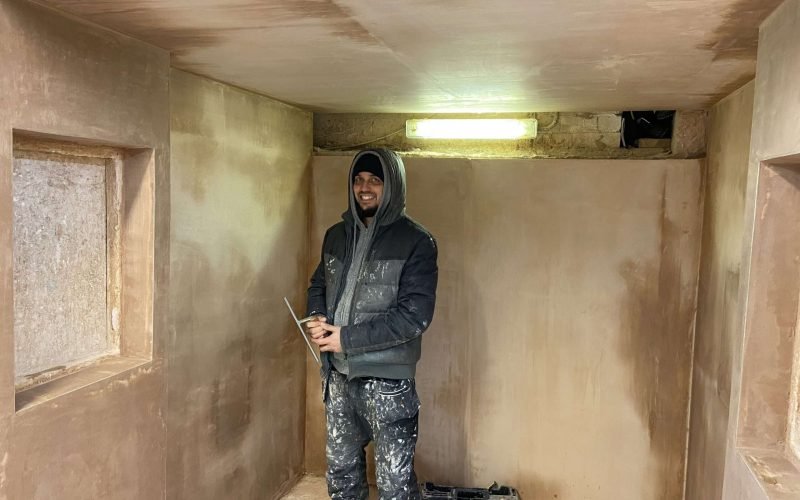Attractive Plastering: Add Special Touches to Your Home's Interior
Attractive Plastering: Add Special Touches to Your Home's Interior
Blog Article
Trick Tips and Tools for Effective Smudging in Your Home Renovation Undertakings
Accomplishing a flawless plaster coating in your house renovation jobs requires a mix of the right tools and tested strategies. Important executes such as the hawk and trowel are essential for efficient application, while correct surface area preparation lays the foundation for success. Furthermore, comprehending the nuances of mixing plaster and applying it in thin layers can substantially influence the last outcome. As we discover these fundamental facets, it ends up being apparent that staying clear of typical challenges can raise your plastering abilities-- guaranteeing your next job not just meets however surpasses assumptions.
Essential Gluing Tools
The necessary devices incorporate a variety of implements developed to facilitate the smudging procedure efficiently and successfully. Secret components consist of a hawk, which is a level, square device used to hold the plaster while applying it to surface areas.

In addition, a mixing pail is required for preparing plaster, ensuring the best consistency before application (Plastering). With each other, these important plastering tools allow both specialists and Do it yourself lovers to attain high-grade results in their gluing projects.
Surface Preparation Strategies
Properly preparing the surface prior to gluing is crucial for guaranteeing adhesion and attaining a perfect surface. The very first step involves cleaning up the surface area to remove any dust, grease, or old paint that may hinder the plaster's ability to bond efficiently. A comprehensive laundry with an ideal cleansing option is recommended, followed by permitting the surface area and washing to dry entirely.
Next, assess the surface area for any imperfections or fractures. These ought to be filled up with a suitable filler substance and permitted to heal according to the maker's directions. For porous surface areas, applying a primer is crucial to develop a consistent texture and boost adhesion.
Furthermore, it is crucial to make sure that the surface is steady and structurally audio. Any type of loose materials, such as flaking paint or damaged drywall, need to be repaired or removed. Think about utilizing a scrape layer to improve hold. if functioning with stonework surfaces.
Mixing Plaster Like a Pro

Using a tidy blending container, put the water first, after that gradually include the plaster powder while mixing continually. This method aids to prevent clumping and makes sure an also distribution of materials.
As soon as mixed, permit the plaster to relax for a few mins to enable the plaster crystals to moisturize fully. This pause improves workability and lowers the risk of cracking during application. By complying with these actions, you can mix plaster like a professional, establishing the structure for a successful smudging project in your house improvement endeavors.
Application Methods for Smooth Finishes
With the plaster combination prepared to the excellent uniformity, the next action involves selecting proper application methods to achieve a smooth finish. The option of application devices significantly affects the final appearance of the plastered surface. For optimum results, a stainless-steel trowel is commonly advised. This tool permits a fine, even circulation of plaster throughout the surface area while decreasing trowel marks - Plastering.
Begin by using a generous amount of plaster to the surface making use of the trowel, guaranteeing it sticks well. Once the preliminary layer is applied, use a sweeping movement to smooth the surface area, using even pressure.
For the final touches, a moist sponge can be used to fine-tune the surface area better. Lightly Home Page haze the plaster with water and delicately rub the surface to achieve a sleek impact. Always bear in mind to function in tiny sections to preserve control over the application process, ensuring a smooth, specialist surface throughout your plastering project.
Usual Mistakes to Avoid
When starting a gluing project, avoiding typical blunders is important for achieving a perfect surface. Among the most common errors is ignoring surface prep work. Falling short to clean and repair the substrate can bring about bad adhesion and unequal surface areas. Make sure that all dirt, grease, and loosened materials are eliminated prior to applying plaster.
One more usual error is applying plaster also thickly. Thick layers can visite site break as they dry out, compromising the honesty of the surface. Instead, select several thin layers, permitting each coat to completely dry completely prior to applying the next.
Additionally, poor mixing methods can cause irregular appearance and workability. Always comply with the maker's instructions for mixing proportions and thoroughly mix the plaster to attain a consistent uniformity.

Timing additionally plays a critical role; plaster needs to be applied while the substratum is moist to boost adhesion. High-quality trowels and drifts can make a significant difference in attaining a smooth surface.
Conclusion
Effective plastering requires a complete understanding of necessary tools and strategies. Mastery of these aspects not only adds to the aesthetic charm of a room yet also guarantees sturdiness and longevity in gluing tasks, making them important to successful home renovation ventures.
A float is one more essential tool, which aids in leveling the plaster and achieving an uniform surface area.

By complying with these actions, you can mix plaster like a pro, setting the foundation for a successful gluing task in your home renovation ventures.
Lightly mist the plaster with water and delicately massage the surface to attain a polished effect.
Report this page